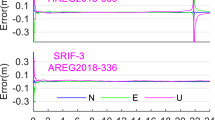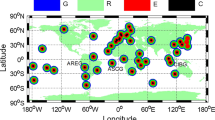Abstract
Sidereal filtering is a technique used to reduce errors caused by multipath in the positioning of static receivers via the Global Positioning System (GPS). It relies upon the receiver and its surrounding environment remaining static from one day to the next and takes advantage of the approximately sidereal repeat time of the GPS constellation geometry. The repeating multipath error can thus be identified, usually in the position domain, and largely removed from the following day. We describe an observation-domain sidereal filter algorithm that operates on undifferenced ionospheric-free GPS carrier phase measurements to reduce errors caused by multipath. It is applied in the context of high-rate (1 Hz) precise point positioning of a static receiver. An observation-domain sidereal filter (ODSF) is able to account for the slightly different repeat times of each GPS satellite, unlike a position-domain sidereal filter (PDSF), and can hence be more effective at reducing high-frequency multipath error. Using 8-h long datasets of GPS measurements from two different receivers with different antenna types and contrasting environments, the ODSF algorithm is shown overall to yield a position time series 5–10 % more stable, in terms of Allan deviation, than a PDSF over nearly all time intervals below about 200 s in length. This may be particularly useful for earthquake and tsunami early warning systems where the accurate measurement of small displacements of the ground over the period of just a few minutes is crucial. However, the sidereal filters are also applied to a third dataset during which two short episodes of particularly high-frequency multipath error were identified. These two periods are analyzed in detail and illustrate the limitations of using sidereal filters with important implications for other methods of correcting for multipath at the observation level.








Similar content being viewed by others
References
Agnew DC, Larson KM (2007) Finding the repeat times of the GPS constellation. GPS Solut 11:71–76. doi:10.1007/s10291-006-0038-4
Allan DW (1966) Statistics of atomic frequency standards. Proc IEEE 54:221–230. doi:10.1109/PROC.1966.4634
Axelrad P, Larson KM, Jones B (2005) Use of the correct satellite repeat period to characterize and reduce site-specific multipath errors. In: Proceedings of ION GNSS 2005, Inst. Navig. Long Beach, CA, pp 2638–2648
Bilich A, Larson KM (2008) Mapping the GPS multipath environment using the signal-to-noise ratio (SNR). Radio Sci 42:RS6003. doi:10.1029/2007RS003652
Bilich AL, Cassidy JF, Larson KM (2008) GPS seismology: application to the 2002 Mw 7.9 Denali Fault earthquake. Bull Seismol Soc Am 98:593–606. doi:10.1785/0120070096
Bock Y (1991) Continuous monitoring of crustal deformation. GPS World 2:40–47
Boehm J, Niell A, Tregoning P, Schuh H (2006) Global Mapping Function (GMF): a new empirical mapping function based on numerical weather model data. Geophys Res Lett 33:L07304. doi:10.1029/2005GL025546
Choi K, Bilich AL, Larson KM, Axelrad P (2004) Modified sidereal filtering: implications for high-rate GPS positioning. Geophys Res Lett 31:L22608. doi:10.1029/2004GL021621
Collins JP (1999) Assessment and development of a tropospheric delay model for aircraft users of the global positioning system. Dissertation. University of New Brunswick, New Brunswick
IERS Conventions (2010) In: Petit G, Luzum B (eds) Frankfurt am Main: Verlag des Bundesamts für Kartographie und Geodäsie, IERS Technical Note 36, pp 179. ISBN:3-89888-989-6. http://www.iers.org/IERS/EN/Publications/TechnicalNotes/tn36.html
Dach R, Brockmann E, Schaer S et al (2009) GNSS processing at CODE: status report. J Geod 83:353–365. doi:10.1007/s00190-008-0281-2
Elósegui P, Davis JL, Oberlander D et al (2006) Accuracy of high-rate GPS for seismology. Geophys Res Lett 33:L11308. doi:10.1029/2006GL026065
Ferre-Pikal ES, Walls FL (2005) Frequency standards, characterization. Encycl RF Microw Eng. doi:10.1002/0471654507
Friederichs T (2010) Analysis of geodetic time series using Allan variances. Dissertation. University of Stuttgart, Stuttgart
Fuhrmann T, Luo X, Knöpfler A, Mayer M (2014) Generating statistically robust multipath stacking maps using congruent cells. GPS Solut 19:83–92. doi:10.1007/s10291-014-0367-7
Geng J, Bock Y, Melgar D et al (2013) A new seismogeodetic approach applied to GPS and accelerometer observations of the 2012 Brawley seismic swarm: implications for earthquake early warning. Geochem Geophys Geosystems. doi:10.1002/ggge.20144
Genrich JF, Bock Y (1992) Rapid resolution of crustal motion at short ranges with the global positioning system. J Geophys Res 97:3261–3269. doi:10.1029/91JB02997
Granström C (2006) Site-dependent effects in high-accuracy applications of GNSS. Technical Report L-Department of Radio and Space Science. Chalmers University of Technology, Göteborg, Sweden. http://publications.lib.chalmers.se/publication/21268-site-dependenteffects-in-high-accuracy-applications-of-gnss
Groves PD (2013) Principles of GNSS, inertial, and multisensor integrated navigation systems, 2nd edn. Artech House, London
Harris RB (2002) Evaluation, refinement and fusion of software-based pseudorange multipath mitigation techniques. In: Proceedings of the ION GNSS Meeting 2002, Inst. Navig. Portland, OR, pp 460–471
Hung H-K, Rau R-J (2013) Surface waves of the 2011 Tohoku earthquake: observations of Taiwan’s dense high-rate GPS network. J Geophys Res Solid Earth 118:332–345. doi:10.1029/2012JB009689
Kouba J (2009) A guide to using International GNSS Service (IGS) products. https://igscb.jpl.nasa.gov/igscb/resource/pubs/UsingIGSProductsVer21.pdf. Accessed 16 June 2015
Langbein J (2004) High-rate real-time GPS network at Parkfield: utility for detecting fault slip and seismic displacements. Geophys Res Lett 13:L15S20. doi:10.1029/2003GL019408
Larson KM, Bilich A, Axelrad P (2007) Improving the precision of high-rate GPS. J Geophys Res Solid Earth 112:B05422. doi:10.1029/2006JB004367
Lau L (2012) Comparison of measurement and position domain multipath filtering techniques with the repeatable GPS orbits for static antennas. Surv Rev 44:9–16. doi:10.1179/1752270611Y.0000000003
Leick A, Rapoport L, Tatarnikov D (2015) GPS satellite surveying, 4th edn. Wiley, Hoboken
Lyard F, Lefevre F, Letellier T, Francis O (2006) Modelling the global ocean tides: modern insights from FES2004. Ocean Dyn 56:394–415. doi:10.1007/s10236-006-0086-x
Misra P, Enge P (2001) Global Positioning System: signals, measurements, and performance, 1st edn. Ganga-Jamuna Press, Lincoln
Moore M, Watson CS, King MA et al (2014) Empirical modelling of site-specific errors in continuous GPS data. J Geod 88:887–900. doi:10.1007/s00190-014-0729-5
Ragheb AE, Clarke PJ, Edwards SJ (2007) GPS sidereal filtering: coordinate- and carrier-phase-level strategies. J Geod 81:325–335. doi:10.1007/s00190-006-0113-1
Reuveni Y, Kedar S, Owen SE et al (2012) Improving sub-daily strain estimates using GPS measurements. Geophys Res Lett 39:L11311. doi:10.1029/2012GL051927
Riley WJ (2008) Handbook of frequency stability analysis. National Institute of Standards and Technology, Boulder
Shi J (2012) Precise point positioning integer ambiguity resolution with decoupled clocks. University of Calgary, Thesis
Takasu T (2006) High-rate precise point positioning: observation of crustal deformation by using 1-Hz GPS data. In: GPS/GNSS Symposium, Tokyo
Wanninger L, May M (2000) Carrier phase multipath calibration of GPS reference stations. In: Proceedings of ION GPS 2000, Inst Navig. Salt Lake City, UT, pp 113–124
Wu JT, Wu SC, Hajj GA et al (1993) Effects of antenna orientation on GPS carrier phase measurements. Manuscr Geod 18:91–98
Zumberge JF, Heflin MB, Jefferson DC et al (1997) Precise point positioning for the efficient and robust analysis of GPS data from large networks. J Geophys Res 102:5005–5017
Acknowledgments
The authors would like to thank Leica Geosystems UK and the UNAVCO Plate Boundary Observatory for access to GPS data and Dr. Paul Groves for his useful comments. This research is a result of collaboration between University College London (UCL) and the Centre for the Observation and Modelling of Earthquakes, Volcanoes and Tectonics (COMET+). This research is funded by a scholarship from UCL.
Author information
Authors and Affiliations
Corresponding author
Rights and permissions
About this article
Cite this article
Atkins, C., Ziebart, M. Effectiveness of observation-domain sidereal filtering for GPS precise point positioning. GPS Solut 20, 111–122 (2016). https://doi.org/10.1007/s10291-015-0473-1
Received:
Accepted:
Published:
Issue Date:
DOI: https://doi.org/10.1007/s10291-015-0473-1




